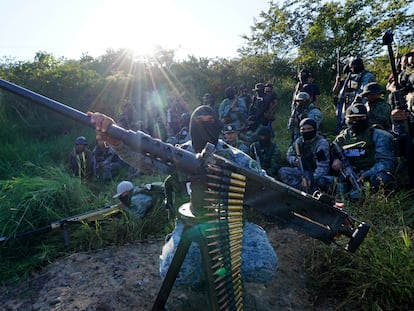News of a stagnant war in Sinaloa
The battle between cartel factions has been going on for five months, with hundreds dead and missing. Los Chapitos have suffered more from the onslaught of the authorities, who have focused their actions on the capital, Culiacán
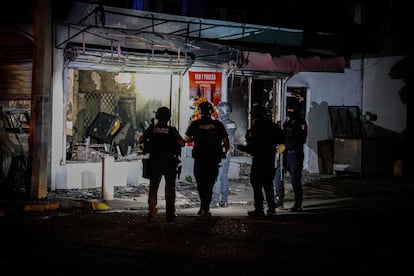
Months go by and the war continues in Sinaloa, in the northwest of Mexico. The fighting is particularly intense in Culiacán and its southern districts, the rural communities on the road to Mazatlán. The state capital is bearing the brunt of the battle between factions of the Sinaloa Cartel, mainly Los Chapitos, led by the sons of Joaquín “El Chapo” Guzmán and Los Mayos, loyal to Ismael “El Mayo” Zambada. Los Chapitos are defending their territory in Culiacán, their stronghold, with the authorities on their heels; Los Mayos, avengers of the supposed betrayal that led to the capture of their leader in the U.S. last year, continue the siege from the south and the mountains.
Although at a slower pace than late last year, shootings are a daily event in the region and the dead continue to appear in the streets. At stake is control of a multimillion-dollar business, focused mainly on drug trafficking to the United States. Since the beginning of September, when hostilities began, violence has swept everything away, like a tsunami. The local economy is suffering and the night has become forbidden territory. The trigger for the violence was the alleged betrayal of Joaquín Guzmán López, El Mayo’s godson, who summoned the cartel kingpin to a meeting that ended with the latter in the clutches of the U.S. justice system, from where it is more than likely he will never emerge.
Since then, more than 800 murders and 950 disappearances have been recorded in Sinaloa, as well as thousands of stolen cars, which fuel the battle. The daily averages are much higher than in previous months and years, when the state was the almost perfect example of the so-called “pax narca,” a situation recounted in dozens of narco-corridos, which make up a true encyclopedia of recent criminal history. Still, something has changed, which is not necessarily for the better. “The fight is like a stalemate,” says a local journalist, who asks that his name be omitted for security reasons. “Now there is a lot of government [presence], especially during the day. The operations have been greatly intensified with the military,” he adds.
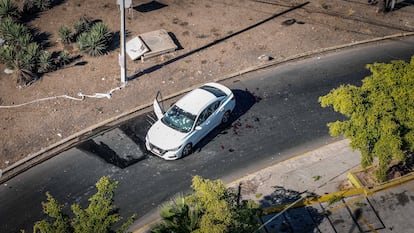
The U.S. administration, with Donald Trump at the helm, is keeping an eye on events south of the Rio Grande. The Mexican government, led by Claudia Sheinbaum, is focusing its security efforts on a few geographical points: Acapulco, on its northern border, as demanded by Trump, but above all Sinaloa, where it has sent thousands of soldiers and national guardsmen, as well as Sheinbaum’s security czar, Omar García Harfuch, who spent Christmas there and provides regular reports on the results of his strategy. As of January 9, the last cut-off date, 558 people had already been arrested — among them “43 priority targets” — hundreds of weapons confiscated, and thousands of kilos of drugs and chemical precursors seized.
Reportedly, other than the long-suffering civilian population, Los Chapitos — now commanded by Iván Archivaldo Guzmán, a priority target for the U.S. government, which is offering $10 million for information leading to his capture — are being hit hardest. An analysis by EL PAÍS of 85 of the 558 arrests made since October, all highlighted by the current administration in its biweekly or daily reports, reveals the blows dealt to the faction led by El Chapo’s sons. Of those 85 arrests, between 48 and 54 were men loyal to the Guzmáns. On the other hand, the authorities have only detained 15 or 16 members of the opposing faction, commanded by Ismael Zambada Sicairos, alias “Mayito Flaco,” El Mayo’s son. There is no certainty about the affiliation of the rest of the Sinaloa splinter groups.
“Eighty to ninety percent of the arrests are of Guzmán loyalists, who knows why,” says an agent from one of the security corporations who has worked on the ground in Sinaloa in these months of war. “The Guzmáns bring in a lot of young guys and Los Mayos are older people,” he adds. The journalist cited above adds a nuance. “Well, they are more out on the streets, making sure that the others don’t get involved. That’s why they get caught,” he argues. This is how the war has developed, with Los Chapitos trying to defend their positions and businesses in Culiacán, while Los Mayos, according to the accounts of both sources, attempt to take positions in the south, from Imala and Sanalona, on the road to the mountains, Costa Rica and Villa Juárez, with occasional incursions into the city.
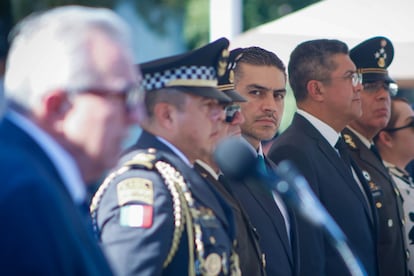
There is no way of knowing who is winning, if wars like this ever have victors. Los Chapitos lost “El Nini” at the end of 2023, their head of security and the man responsible for the Culiacanazos, the violent reactions of Los Chapitos to the attempted arrest of another of El Chapo’s sons, Ovidio Guzmán, that turned the city into a battlefield, first in 2019 and then in 2023. Then “El Chore” and “El Piyi,” lieutenants of the Guzmán brothers, fell. More recently, El Pelón de Sonoyta, who the Sheinbaum government singled out as “coordinator of Los Chapitos’ offensive against Los Mayos in Sinaloa.” The authorities have also dealt several blows to a subgroup of one of the organization’s main operators in Culiacán, El Perris, with arrests and seizures, and they also arrested Ovidio Guzmán’s uncle in December, who they accuse of fentanyl trafficking.
On the other hand, the biggest capture was that of Juan Carlos Félix Gastélum, alias “El Chavo Félix,” in mid-January. Gastélum is the son-in-law of El Mayo Zambada. According to the government, El Chavo Félix was an important piece in Los Mayos’ operation as “he maintained control in the southeastern area of Culiacán and had presence and influence in Quilá.” Also noteworthy is the capture of a cell leader in Zambada’s faction, “El Max,” last October, in a suspicious confrontation with the military that left 19 alleged criminals dead and a clean slate for the soldiers. Although according to the agent cited above, El Max, captured in a safe house near Sanalona, was not very important in the support network of Los Mayos, whose structure would have remained almost intact.
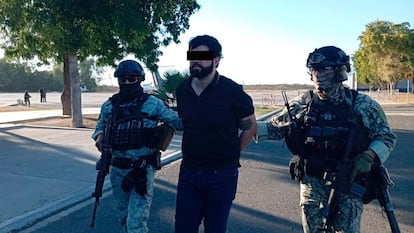
It is difficult to know how long this current war will last, a cyclical phenomenon in the Sinaloa Cartel. After El Chapo was arrested a few years ago, his sons faced off for control against an old ally of the capo, Dámaso López, alias “El Licenciado,” and his faction. Los Chapitos came out on top and López was arrested and extradited to the U.S. A decade and a half ago, another nebulous deception, with the Guzmáns and the Beltrán Leyva family as protagonists, unleashed a war that lasted three years. “This is going to continue for months and months, if not years. That is how it was when they caught El Mochomo,” says the agent, referring to Alfredo Beltrán Leyva, the main leader of the faction. His arrest in 2008 caused a schism with the Guzmáns, which was never resolved. “This is not going to stop until one of them is forced to give in, between Mayito and Iván,” he concludes. “And Zambada’s partners are stronger.”
Sign up for our weekly newsletter to get more English-language news coverage from EL PAÍS USA Edition
Tu suscripción se está usando en otro dispositivo
¿Quieres añadir otro usuario a tu suscripción?
Si continúas leyendo en este dispositivo, no se podrá leer en el otro.
FlechaTu suscripción se está usando en otro dispositivo y solo puedes acceder a EL PAÍS desde un dispositivo a la vez.
Si quieres compartir tu cuenta, cambia tu suscripción a la modalidad Premium, así podrás añadir otro usuario. Cada uno accederá con su propia cuenta de email, lo que os permitirá personalizar vuestra experiencia en EL PAÍS.
¿Tienes una suscripción de empresa? Accede aquí para contratar más cuentas.
En el caso de no saber quién está usando tu cuenta, te recomendamos cambiar tu contraseña aquí.
Si decides continuar compartiendo tu cuenta, este mensaje se mostrará en tu dispositivo y en el de la otra persona que está usando tu cuenta de forma indefinida, afectando a tu experiencia de lectura. Puedes consultar aquí los términos y condiciones de la suscripción digital.
More information
Archived In
Últimas noticias
Kate Winslet makes her directorial debut: ‘There aren’t more female directors because we’re busy raising children’
ChatGPT fails the test: This is how it endangers the lives of minors
The late consecration of women artists in their 90s
The Florida Keys tourist paradise is besieged by immigration agents: ‘We’ve never seen anything like this’
Most viewed
- Families demand repatriation of bodies of Colombians who died in Ukraine: ‘This war is a slaughterhouse for foreigners’
- The low-cost creative revolution: How technology is making art accessible to everyone
- Liset Menéndez de la Prida, neuroscientist: ‘It’s not normal to constantly seek pleasure; it’s important to be bored, to be calm’
- Christian Louboutin: ‘Young people don’t want to be like their parents. And if their parents wear sneakers, they’re going to look for something else’
- ‘El Limones’ and the growing union disguise of Mexican organized crime

